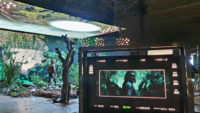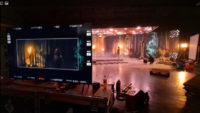Virtual Production Is on Track to Replace More Costly Tools
October 20, 2020
In virtual production, filmmakers marry actors and digital environments in real time. Now, in the United Kingdom, video game developer Rebellion Developments has completed what it says is the first “all virtual” film, the five-minute “Percival,” which was broadcast on Rebellion’s YouTube channel. The company built a studio to create more such virtual productions out of its library of intellectual property. Rebellion said “Percival” was shot entirely in front of large flat screen displays connected to PCs running Unreal Engine.
Engadget reports that the first high-profile use of virtual production was Disney’s “The Mandalorian, “which shot the majority, but not all, of its scenes in these studios … [in a] 270-degree horseshoe of LED displays 20 feet high.”

Just as green screen replaced matte paintings, now virtual production is likely to replace the ubiquitous green screen. Rebellion VFX head He Sun “originally planned to run a visual effects experiment with a rented LED wall,” but Rebellion co-founder and chief executive Jason Kingsley suggested making an entire movie. With three weeks of prep, the shoot was run as a test, with cinematographer Eben Bolter, BSC was brought in to light and shoot.
Bolter said virtual production “enabled better lighting compared to green or blue screen” since there was no reflected green or blue light that would have to be removed in post production. “Percival” used anamorphic lenses which was another benefit of virtual production since, said Bolter, VFX crews “hate anamorphic lenses because they have to artificially emulate [oval bokeh] in post-production.”

It is typically a difficult, long process to shoot any movie on location, and virtual production removes all those obstacles. The real-time results of virtual production can also help “plan the shoot, picking shot angles and lighting styles before set builders bust out the drills and hammers.” “All of the VFX and set extension is done in-camera and on set,” said Sun.
Environments for “Percival” were created by three artists using Unreal Engine in a two-week period. It was also easy to make last-minute changes to the set. All in all, the process was “almost luxurious, especially in terms of the levels of control afforded to filmmakers.” When Bolter suggested a scene in Morocco, he was able to shoot a background plate there rather than move the entire production to another country.
Film.io chief production officer Orlando Pedregosa stated that using LED screens can save “99 percent of the construction and production design budget,” with background plate shots saving around “70 percent, thanks to a reduction in items like transport, insurance, hotels and cast/crew expenses.” That adds up to huge savings on a single set-up for a movie, he added.

No Comments Yet
You can be the first to comment!
Sorry, comments for this entry are closed at this time.